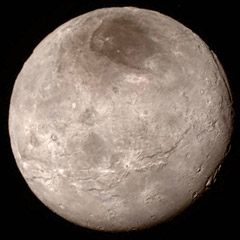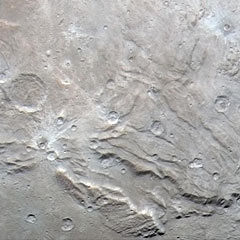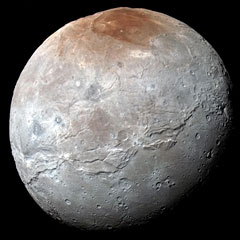 |
 |
 |
||
| New Horizons photo of Charon (NASA-JHUAPL-SwRI) |
New Horizons closeup photo of Charon showing cracks and craters (NASA/JHUAPL/SwRI) |
New Horizons natural color photo of Charon (NASA/JHUAPL/SwRI) |
| Back to Previous Stop | Return to Pluto |
Charon | Continue Tour to Other Moons |
Continue to Next Stop |
The Ferryman of Hades
Charon [SHAR-on] is the first of Pluto's five known moons and is by far the largest. With a diameter of 750 miles (1,208 km), Charon is more than half the size of Pluto. This has led many astronomers to refer to Pluto and Charon as a double planet. In fact, Charon does not actually revolve around Pluto. Instead, the two bodies orbit each other around a common center of gravity located between the two. Charon was named after the mythical ferryman of Hades who carried souls of the newly deceased across the rivers Styx and Acheron that divided the world of the living from the world of the dead. Charon was discovered by by United States Naval Observatory astronomer James Christy, using the 1.55-meter telescope at the Naval Observatory Flagstaff Station (NOFS). Nearly everything we know about Charon was discovered during NASA's New Horizons spacecraft encounter on July 14, 2015.
 |
| New Horizons composite image showing relative sizes and distance for Pluto and its largest moon, Charon. NASA/JHUAPL/SWRI) |
A Moon of Many Colors
The most obvious feature of Charon is its strong variation in color. Colors on the moon vary from white, to gray, to brown and even red. Charon's surface shows a latitudinal trend in albedo, with a brighter equator and darker poles. The north polar region is dominated by a large dark area that was named "Mordor" by the New Horizons research team. Scientists are really not sure what causes this dark feature. They suspect that it is formed by condensation of gases that escaped from from Pluto's atmosphere. They believe that these gases, which include nitrogen, carbon monoxide, and methane, condense to form ice. When these ices are subjected to solar radiation, they chemically react to form reddish compounds known as tholins. Because its composition and features are so different than those of Pluto, it is possible that Charon was a separate dwarf planet that was captured by Pluto's gravity.
Features of Charon
Unlike Pluto's surface, which is composed mainly of nitrogen and methane ices, Charon's surface appears to be composed mainly of water ice. Observations made in 2007 showed patches of ammonia hydrates and water crystals on the surface of Charon that suggest the presence of active cryogeysers and cryovolcanoes. The lack of craters suggests that Charon has a very young surface. This would tend to indicate that the moon is geologically active. The southern hemisphere has fewer craters than the northern and is considerably less rugged, suggesting that a massive resurfacing event has taken place. This could have been caused by the partial or complete freezing of an internal ocean. This event may have removed many of the earlier craters. One of Charon's most unusual features is the "mountain in a moat". An image from New Horizons showed a mountain rising out of a depression, in a zoomed in view. It appears as a large mountain sitting in a moat. This feature has geologists stunned and stumped.
The Sun
Mercury
Venus
Earth
Mars
Jupiter
Saturn
Uranus
Neptune
Pluto
Asteroids
Comets
Interstellar Space
Your Weight on Other Planets
|
||||||||
| Back to Previous Stop | Return to Pluto |
Return to Top of Page |
Continue to Next Stop |



